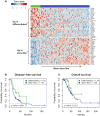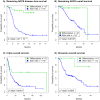Stem cell-like gene expression in ovarian cancer predicts type II subtype and prognosis
- PMID: 23536770
- PMCID: PMC3594231
- DOI: 10.1371/journal.pone.0057799
Stem cell-like gene expression in ovarian cancer predicts type II subtype and prognosis
Abstract
Although ovarian cancer is often initially chemotherapy-sensitive, the vast majority of tumors eventually relapse and patients die of increasingly aggressive disease. Cancer stem cells are believed to have properties that allow them to survive therapy and may drive recurrent tumor growth. Cancer stem cells or cancer-initiating cells are a rare cell population and difficult to isolate experimentally. Genes that are expressed by stem cells may characterize a subset of less differentiated tumors and aid in prognostic classification of ovarian cancer. The purpose of this study was the genomic identification and characterization of a subtype of ovarian cancer that has stem cell-like gene expression. Using human and mouse gene signatures of embryonic, adult, or cancer stem cells, we performed an unsupervised bipartition class discovery on expression profiles from 145 serous ovarian tumors to identify a stem-like and more differentiated subgroup. Subtypes were reproducible and were further characterized in four independent, heterogeneous ovarian cancer datasets. We identified a stem-like subtype characterized by a 51-gene signature, which is significantly enriched in tumors with properties of Type II ovarian cancer; high grade, serous tumors, and poor survival. Conversely, the differentiated tumors share properties with Type I, including lower grade and mixed histological subtypes. The stem cell-like signature was prognostic within high-stage serous ovarian cancer, classifying a small subset of high-stage tumors with better prognosis, in the differentiated subtype. In multivariate models that adjusted for common clinical factors (including grade, stage, age), the subtype classification was still a significant predictor of relapse. The prognostic stem-like gene signature yields new insights into prognostic differences in ovarian cancer, provides a genomic context for defining Type I/II subtypes, and potential gene targets which following further validation may be valuable in the clinical management or treatment of ovarian cancer.
Conflict of interest statement
Figures


Similar articles
-
Molecular subtyping of serous ovarian tumors reveals multiple connections to intrinsic breast cancer subtypes.PLoS One. 2014 Sep 16;9(9):e107643. doi: 10.1371/journal.pone.0107643. eCollection 2014. PLoS One. 2014. PMID: 25226589 Free PMC article.
-
High-grade serous tubo-ovarian cancer refined with single-cell RNA sequencing: specific cell subtypes influence survival and determine molecular subtype classification.Genome Med. 2021 Jul 9;13(1):111. doi: 10.1186/s13073-021-00922-x. Genome Med. 2021. PMID: 34238352 Free PMC article.
-
Gene expression classification of colon cancer into molecular subtypes: characterization, validation, and prognostic value.PLoS Med. 2013;10(5):e1001453. doi: 10.1371/journal.pmed.1001453. Epub 2013 May 21. PLoS Med. 2013. PMID: 23700391 Free PMC article.
-
Deconstructing the molecular portrait of basal-like breast cancer.Trends Mol Med. 2006 Nov;12(11):537-44. doi: 10.1016/j.molmed.2006.09.004. Epub 2006 Sep 29. Trends Mol Med. 2006. PMID: 17011236 Review.
-
Ovarian cancer and the evolution of subtype classifications using transcriptional profiling†.Biol Reprod. 2019 Sep 1;101(3):645-658. doi: 10.1093/biolre/ioz099. Biol Reprod. 2019. PMID: 31187121 Review.
Cited by
-
Screening of feature genes of the ovarian cancer epithelia with DNA microarray.J Ovarian Res. 2013 Jun 5;6(1):39. doi: 10.1186/1757-2215-6-39. J Ovarian Res. 2013. PMID: 23738901 Free PMC article.
-
PTTG1: a Unique Regulator of Stem/Cancer Stem Cells in the Ovary and Ovarian Cancer.Stem Cell Rev Rep. 2019 Dec;15(6):866-879. doi: 10.1007/s12015-019-09911-5. Stem Cell Rev Rep. 2019. PMID: 31482269 Free PMC article.
-
YAP/TEAD co-activator regulated pluripotency and chemoresistance in ovarian cancer initiated cells.PLoS One. 2014 Nov 4;9(11):e109575. doi: 10.1371/journal.pone.0109575. eCollection 2014. PLoS One. 2014. PMID: 25369529 Free PMC article.
-
Derivation of a fifteen gene prognostic panel for six cancers.Sci Rep. 2015 Aug 14;5:13248. doi: 10.1038/srep13248. Sci Rep. 2015. PMID: 26272668 Free PMC article.
-
Distance in cancer gene expression from stem cells predicts patient survival.PLoS One. 2017 Mar 23;12(3):e0173589. doi: 10.1371/journal.pone.0173589. eCollection 2017. PLoS One. 2017. PMID: 28333954 Free PMC article.
References
-
- Jemal A, Siegel R, Xu J, Ward E (2010) Cancer statistics, 2010. CA Cancer J Clin 60: 277–300. - PubMed
-
- Jazaeri AA, Awtrey CS, Chandramouli GV, Chuang YE, Khan J, et al. (2005) Gene expression profiles associated with response to chemotherapy in epithelial ovarian cancers. Clin Cancer Res 11: 6300–6310. - PubMed
-
- Curley MD, Garrett LA, Schorge JO, Foster R, Rueda BR (2011) Evidence for cancer stem cells contributing to the pathogenesis of ovarian cancer. Front Biosci 16: 368–392. - PubMed
Publication types
MeSH terms
Grants and funding
LinkOut - more resources
Full Text Sources
Other Literature Sources
Medical

